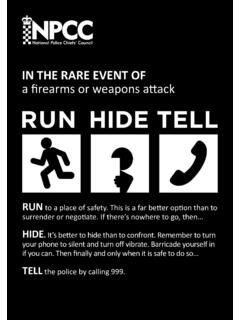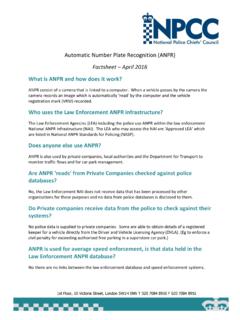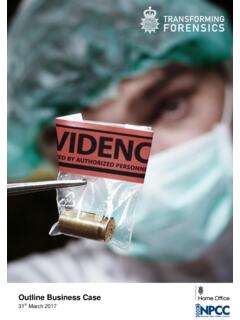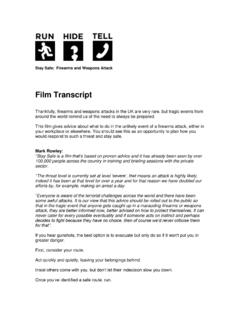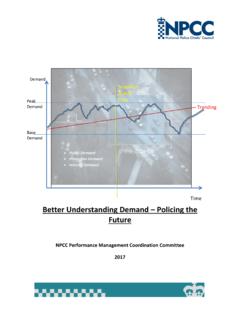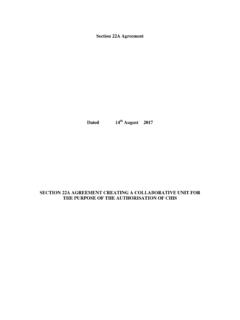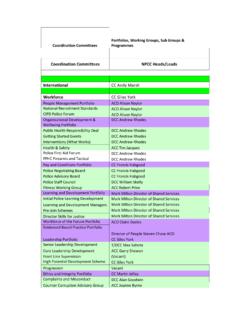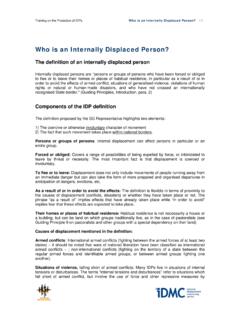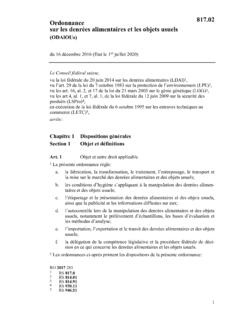Transcription of Guidance on the Use of Incapacitant Spray
1 ACPO Guidance on the use of Incapacitant Spray Date printed: 04/11/10 Version 2 1 of 22 Security Classification: NOT PROTECTIVELY MARKED Disclosable under FOIA 2000: Yes Association of Chief Police Officer of England, Wales & Northern Ireland Guidance on the Use of Incapacitant Spray Status: This Guidance is published by the Self-Defence, Arrest & Restraint Working Group of the Uniformed Operations Business Area. It is disclosable under the Freedom of Information Act 2000, and has been audited in line with ACPO requirements and is subject to copyright laws. Implementation Date: Review Date: Copyright 2009.
2 All rights reserved. Association of Chief Police Officers of England, Wales and Northern Ireland. Registered number: 344583: 10 Victoria Street, London. SW1H 2009 May 2012 ACPO Guidance on the use of Incapacitant Spray Date printed: 04/11/10 Version 2 2 of 22 CONTENTS PAGE Section Page number 1. Preface 3 2. Guidance , advice and procedures 4 3. Operational tactics [for separation if subject to FOI] 15 4.
3 Learning requirement 16 5. Appendices 18 ACPO Workbook A [The public document will only contain the Diversity Impact Assessment section of the Workbook] Other Appendices B - ACPO Guidance on the use of Incapacitant Spray Date printed: 04/11/10 Version 2 3 of 22 SECTION 1 - PREFACE Guidelines of the Use of Incapacitant Spray The information contained in this document is designed to provide police officers and other police staff with an overarching, generic approach to the use of Incapacitant Spray . The Guidance should not be viewed in isolation but seen as the guiding principles and fundamental approach, underpinning the specific training provided to all staff issued with Incapacitant Spray .
4 The use of Incapacitant Spray should be seen in the context of the Conflict Management Model as a whole and their use viewed as one of the many tactical options that may be available to staff in the resolution of an incident. These notes have been written on behalf of the Association of Chief Police Officers (ACPO) by the Strategic Firearms & Conflict Management Portfolio Working Group on Self-Defence, Arrest and Restraint (SDAR). Their purpose is to support and inform decision making in relation to the deployment and use of Incapacitant Spray . The Guidance provided is for the benefit of chief constables and police staff who may be required to use Incapacitant Spray .
5 The nature of policing is so diverse that it will never be possible to document Guidance to cover every encounter or eventuality; what is important is that any action taken is lawful. Action must be proportionate to the competing rights of individuals and any force used should be no more than absolutely necessary in the circumstances. In this regard individual officers must be prepared to account for their decisions, to show that they were justified in doing what they did and that they acted reasonably within the scope of the law on the use of force.
6 Similarly, chief officers will need to be in a position to justify any decision or action in order to avoid or defend civil claims. ACPO Guidance on the use of Incapacitant Spray Date printed: 04/11/10 Version 2 4 of 22 SECTION 2 - Guidance , ADVICE AND PROCEDURES CS Incapacitant Spray Description of Equipment Irritant is dispensed from a hand held aerosol canister in a liquid stream that contains a 5% solution of CS (2-chlorobenzylidene malononitrile) in the solvent Methyl Isobutyl Ketone (MIBK). The propellant is nitrogen. A 5% solution has been selected because this is the minimum concentration which will fulfil the purpose of the equipment; namely to minimise a person s capacity for resistance without unnecessarily prolonging their discomfort.
7 The liquid stream is directional and has a range of up to 4 metres. Maximum accuracy, however, will be achieved over a distance of - 2 metres. The operating distance is the distance between the canister and the subject s eyes not the distance between the officer and the subject. Effects of CS CS is a peripheral sensory irritant. In most cases spraying will result in the subject s eyes being forced shut, a burning sensation on the skin around the eyes and face, when inhaled their breathing may be affected. In most cases this action will be sufficient to render a subject incapable of continuing an attack.
8 The effects may be instantaneous or can be delayed for up to 20 seconds. It should, however, be remembered that no Incapacitant is universally effective and there may be individuals on whom an Incapacitant may not be effective at all or only partially so. Exposure to fresh moving air will normally result in a significant recovery from the effects of CS within 15 - 20 minutes. ACPO Guidance on the use of Incapacitant Spray Date printed: 04/11/10 Version 2 5 of 22 PAVA Incapacitant Spray - Description of Equipment Captor I - Irritant is dispensed from a hand held canister in a liquid stream that contains a solution of PAVA (Pelargonic Acid Vanillylamide) in a solvent of aqueous ethanol.
9 The propellant is nitrogen. Captor II - Irritant is dispensed from a hand held canister in a liquid stream that contains a solution of PAVA in a solvent of monopropylene glycol, water and ethanol. The propellant is nitrogen. Captor I & Captor II - A solution has been selected because this is the minimum concentration which will fulfil the purpose of the equipment; namely to minimise a person s capacity for resistance without unnecessarily prolonging their discomfort. It should be noted that PAVA is significantly more potent than CS.
10 The liquid stream is a Spray pattern and has a maximum effective range of up to 4 metres. Maximum accuracy, however, will be achieved over a distance of - 2 metres. The operating distance is the distance between the canister and the subject s eyes not the distance between the officer and the subject. Effects of PAVA PAVA primarily affects the eyes causing closure and severe pain. The pain to the eyes is reported to be greater than that caused by CS. The effectiveness rate is very high once PAVA gets into the eyes.

